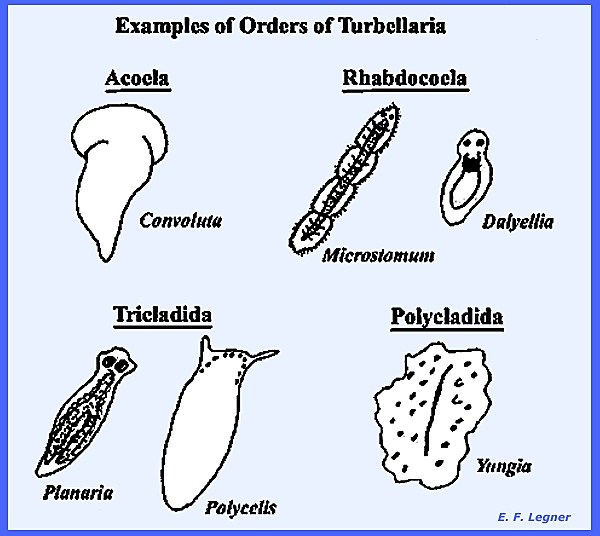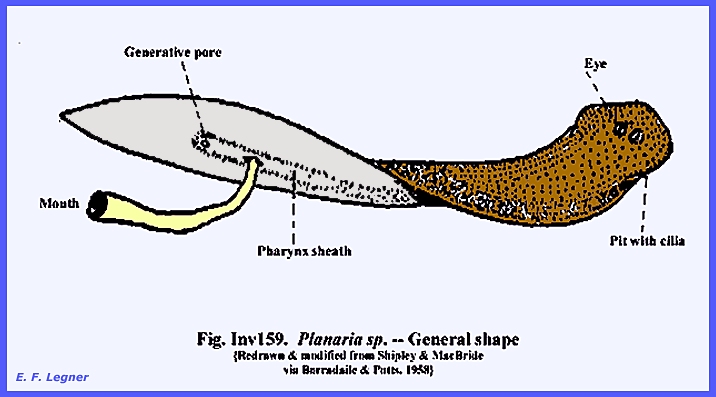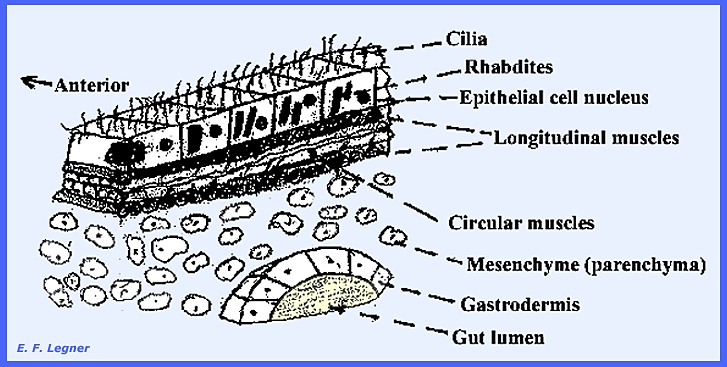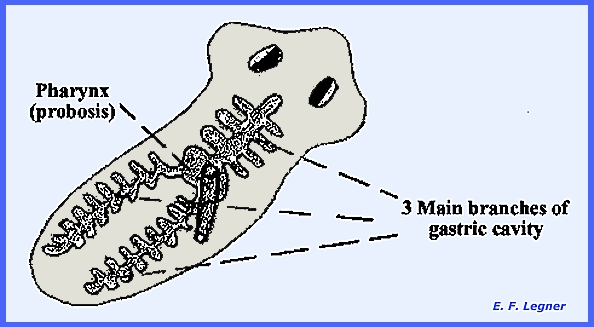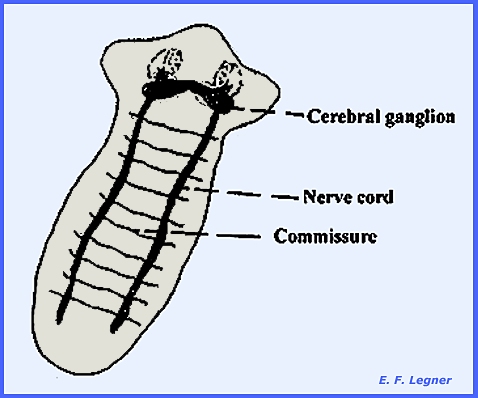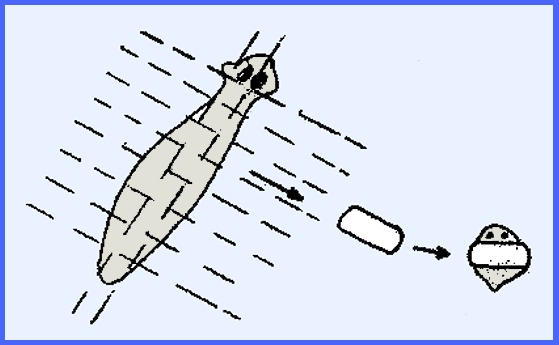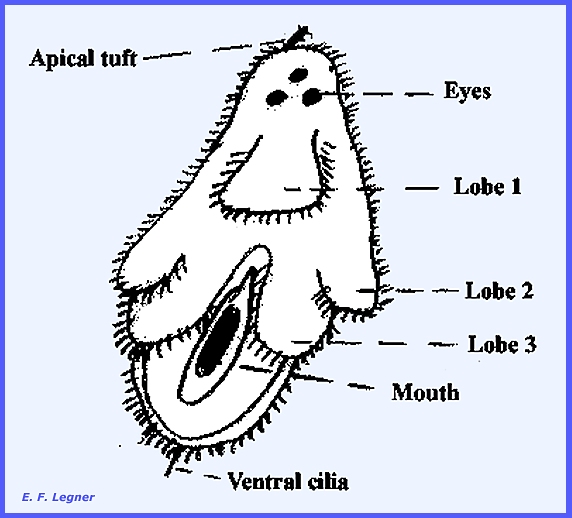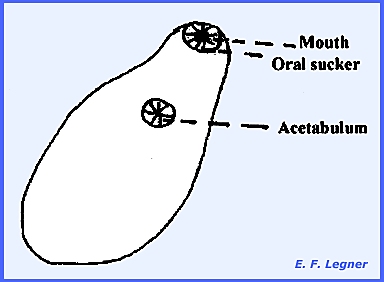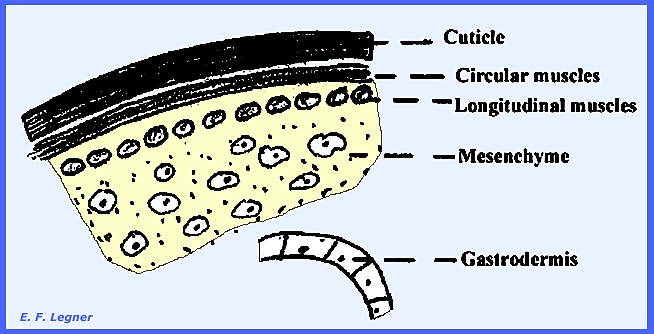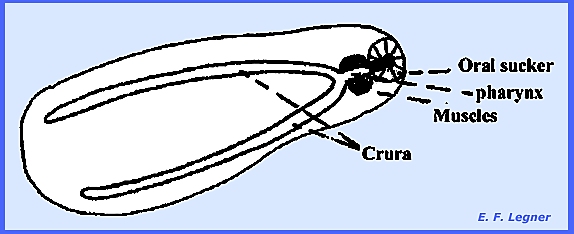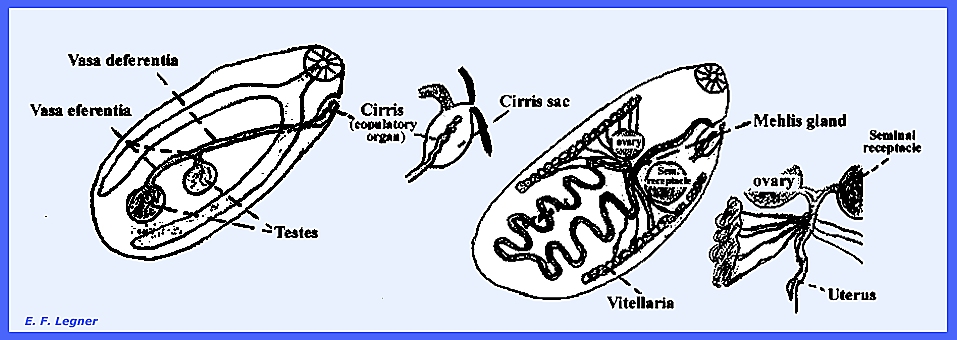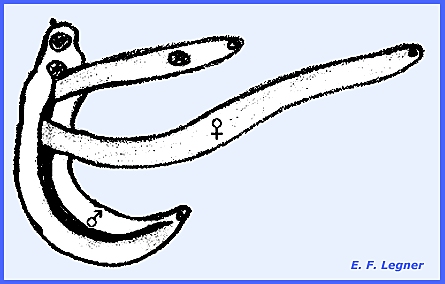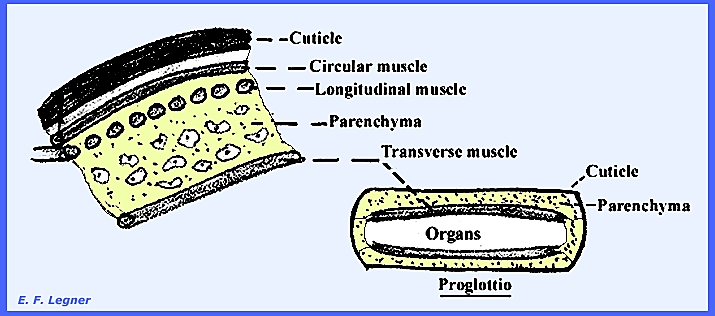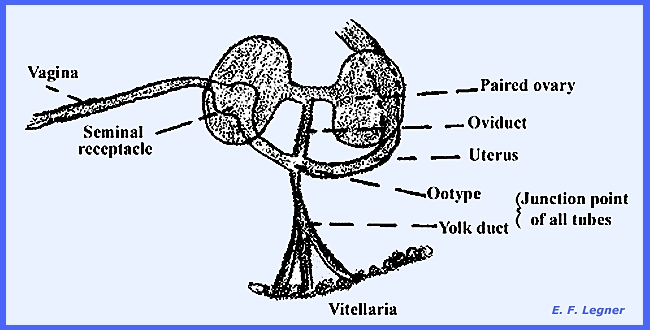File:
<platyhelminthes.htm> <Index to Invertebrates> <Bibliography> <Glossary> Site Description <Navigate to Home>
|
Invertebrate
Zoology Animalia, SubKingdom: Metazoa,. Platyhelminthes (Contact)
CLICK on underlined file names and
included illustrations to enlarge: The Phylum: Platyhelminthes includes the flatworms
(Planaria, flukes & tapeworms)
Three Classes treated here are Turbellaria,
Trematoda and Cestoda. The Class Turbellaria
is distinguished mainly
on the appearance of the digestive tract.
Four orders discussed are Acoela, Rhabdocoela, Tricladida and
Polycladida as follows: Order Acoela (= "no gut"). There is a mouth
and pharynx but no digestive cavity and so are similar to the planula
larva. Endoderm cells distribute
food. Order Rhabdocoela (=
"straight gut"). These have
a straight digestive cavity. Both
fresh water and marine forms occur.
Asexual reproduction involves the production of chains of individuals,
which remain attached to each other.
Nematocysts are aacquired from a Cnidarian diet. Order Tricladida
(= 3-branches"). There are three main branches of the
digestive tract, such as is found in the genus Planaria. There are mostly fresh water forms. Order Polycladida
(= "many branches"). All are marine and branches of gut run out
radially from the pharynx. Simple
sketches of the four orders are shown in the following diagram:
Platyhelminthes includes the familiar Planaria
of elementary classrooms and the appalling flukes and tapeworms that have
plagued humans for millennia. The
phylum is distinguished by showing bilateral symmetry,
allowing for such designations as anterior, posterior, dorsal, and
ventral. The animals are
dorso-ventrally flattened, and they possess three distinct germ layers during
development and as adults. A distinct
mesoderm layer is first presented here.
The digestive tract has only one opening, which is similar to that of
Cnidaria but more organized. This
also serves as the anus. Flame
cells
are present, which are
excretory cells that are the first structures to appear, which are
exclusively excretory in function. The flatworms
are found widely distributed in both fresh and salt waters, soil and they
occur as parasites of other animals.
They have a well developed system of organs and their reproductive
system is especially well developed. ------------------------------------ The Class Turbellaria is
named such by the little turbulences they create by the beating of their
epidermal cilia. These are mostly
free-living organisms and only a few are commensals and parasites. The body surface, or epidermis, is covered
with cilia. They are found in fresh
and salt water and in the soil, and their size ranges up to about 5 cm. [See Inv159 for
example] A representative Genus is Dugesia
(= Planaria). Their habitat is under objects in fresh
water and so they are readily available over a wide geographic range in North
America. Body
Plan.-- An elongated, ribbon-like animal
exceedingly flat. A proboscis is
carried in a sheath when not in use.
There are two eyespots with a pigment that suggests a "wall
eye." An auricle is present (see
diagram). Body
Wall.
There are cilia on the epidermis, and the epidermis contains
rhabdites, which may function to secrete mucous material, which covers the
body. Rhabdites are
produced in sub epidermal cells and are later moved to the epidermal cells. Circular muscles form a complete
layer around the body circumference. Longitudinal
muscles
are formed around the
circular muscles. A Parenchyma (mesenchyme)
is a disorganized tissue, which fills up the entire interior of the body that
is not occupied by other organs.
Therefore, there is no other cavity than the digestive one. Food
& Digestion.-- The species are
carnivorous and will catch and feed on anything around. The mucous on the body of Dugesia
entangles the prey, while the proboscis enters the prey to suck its
contents. The pharnyx empties into
the digestive cavity, which in turn consists of three parts leading to all
sections of the body. Digestion
commences extracellularly but is terminated intracellularly, just as in the
Cnidaria. There is no anus. Circulation.--
Food is circulated before it is digested.
Distribution is accomplished by diffusion, and flagellated
gastrodermal cells keep the food in motion. Respiration.--
Simple diffusion accomplishes respiration that is similar to previous phyla discussed. This is an advantage of having a flat
body. Excretion.--
Flame
cells
accomplish
excretion. A hollow cavity occurs
inside the flame cell and a tuft of cilia lies in the cavity. Wastes enter the cell and diffuse through
the cavity and then are forced out into the excretory tube by the beating of
cilia. Excretory tubes lead to a
common channel, which has two body openings. Support.--
Little support is required for planarians living in fresh water. Protection.--
The mucous, which is a very sticky mass, entangles would-be predators. Motion.--
There are two kinds of motion in Dugesia. The smooth, gliding motion is achieved in part by the beating
of cilia and in part by muscular contractions of the body wall. Sensitivity.--
Three structures are sensitive. Eye
spots
on the animal are a
shade that overhangs light-sensitive cells.
Auricles are
sensitive to chemical stimulation and aids in the location of food. The whole body surface also is sensitive
to touch and chemical stimuli. Nervous System.--
A cerebral ganglion
is present and there
are two nerve cords on the ventral side that run the length of the body from
the anterior cerebral ganglion.
"Ladder type"
commeasures connect the nerve
cords. Various nerve processes extend
off of the nerve cords. This is the
first nervous system with a coordinating ganglion and the first to show nerve
cords. Reproduction.-- Both sexual
and asexual reproduction is found in Dugesia. The sexual reproduction is the best
developed of all systems. The animals
become sexually mature only at rare intervals, which is triggered by
conditions in the environment. They
are hermaphroditic but cross-fertile.
Any one animal can act as male or female, but only one sex at a
time. The male sexual structures consist
of testes, vasa efferentia (2), vasa deferentia (2), a penis and a genital
pore. The female sexual structures
consist of ovaries, an oviduct, a vagina, a uterus, a bursa and a genital
pore. The genital pore is common to
both male and female. Eggs are laid in a cocoon and vitellaria,
or yolk glands, are present. These glands secrete yolk in the form of
actual cells. The yolk cells are
collected down in the vitellaria and serve to provide food for the developing
embryo. The eggs are ectolecithal as
the yolk occurs on the outside of the egg. During asexual reproduction the
posterior part of the animal simply breaks off. This is the most common means of reproduction in Dugesia. Regeneration.--
This has been widely studied in this group of animals. There is a polarity that exists in each
cut piece. The edge that was closest
to the anterior end of the animal will develop a new head, and that closest
to the posterior end will develop a new tail. Sections cut from the center of the animal will develop into a
whole new animal. Economic Importance.--
No direct importance, but planarians have been used to combat mosquitoes with
some success (see Mosquito
Suppression with Planaria) ------------------------------------ There are many variations in the
form of the digestive tract and the position of the mouth. Many species possess suckers. Sexual reproduction is found in all, but asexual
reproduction is the most common in the group. In Rhabdocoela there are nematocysts, which are acquired from
consuming Cnidiarians. Most
Turbellaria have direct development.
Eggs are held in a cocoon from which adults hatch. A free-swimming larval stage does occur,
which is known as Muller's Larva. ------------------------------------ The Class Trematoda include
the flukes, and two Subclasses will be presented here: Monogenea and Digenea. Monogenea is
a small group whose members are external parasites on the gills of fish, in
the mouth cavity, etc., and some are parasites of cold-blooded vertebrates
and some invertebrates. There is a direct development without a larval stage
or intermediate host. Digenea are
internal parasites, mostly on vertebrates.
There is an indirect development where larval stages are living in
intermediate hosts. The life cycles
of the Digenea are quite complex. [See Inv160 for example] All species of Trematoda are
parasitic but they are mostly internal parasites, with fewer numbers being
external parasites. They are
generally similar in structure to the Turbellaria but with several
modifications. They have more
complicated life cycles that involve several host animals. A representative Genus is Pneumonoeces,
which includes the lung flukes of frogs and toads. The adults of these animals live in the lungs of frogs and
toads, while the larvae are parasitic on snails and dragonflies. Body
Plan.-- This is similar to Dugesia, but
the mouth is located anteriorly and is equipped with a sucker. There is also a sucker on the ventral
surface called the acetabulum that
has no opening. Body
Wall.-- An epidermis is nonexistent in adult
flukes. They have very poorly
developed muscle layers. The
mesenchyme bears cells, which secrete the cuticle. The cuticle protects the fluke from the host's digestive
fluids. There are no cilia, hence no
locomotion! Food
& Digestion.-- Food is derived
from the cells, mucous, blood, etc. of the host's lung. A muscular pharynx located behind the oral
sucker serves as a food pump. There is a single-branched intestinal
tract that has no subdivisions. An
exception is in the sheep liver fluke. Circulation,
Respiration & Excretion.-- These functions are
the same as in the Turbellaria. Support
& Protection.-- The heavy cuticle
supports and protects the animal. Locomotion.
-- There is very little locomotion as there is not much occasion for
movement. Muscle layers are weakly
developed. Sensitivity.--
Although present in the larvae, there are no sense organs in the adult. Sensory cells are generally diminished as
compared to the Turbellaria as there are little external stimuli that reach
these animals due to their interior environment. Nervous System.--
The nervous system is of the same pattern as in Dugesia, but it is not
as well developed and much reduced. Reproduction.--
Both sexual and asexual reproduction is present. In sexual reproduction the animal is hermaphroditic and is self
or cross-fertile. Males have two
testes and a cirrus, which turns inside
out as it is protruded. It is the
expanded, eversible end of the vas deferens.
The base of the cirrus stores sperm and is the seminal vesicle. The female has one ovary, and the
uterus winds around and empties out at the top of the cirrus
sac. A shell plus about 12 yolk cells are put
around the eggs. The eggs are then
laid in tremendous numbers and already contain embryos at the laying time. Asexual reproduction is found in
the life cycle in different hosts.
There are such structures as germ bulbs, rediae, etc. Life
Cycle. -- In Pneumonoeces
the frog coughs up the eggs, they are swallowed and passed out with the
faeces. The miracidium larval
stage then commences. It is covered
with cilia and possesses a pair of eyes and an epidermis. It swims around in the water until it
finds a certain kind of snail. It
then bores through the snail body and turns into a sporocyst. The sporocyst develops germ bulbs
within its body, each bulb developing into the next larval stage, the redia. The redia taken on more characteristics of
the fluke. When the redia is mature
it bursts open to release more rediae.
Inside of these rediae are formed the third larval stage called the cercaria. The cercaria has a tail, but
otherwise it resembles a fluke. In
this stage the snail body is departed and the cercaria swims around by virtue
of its tail. There are eyes present
here. Dragonfly nymphs may consume
the cercaria or they may simply bore through the dragonfly nymph's body
wall. The gut of the dragonfly is
penetrated and a cyst is formed called a metacercaria. The metacercaria remains in the
body of the nymph for its entire development, which may take two or three
years. When a frog consumes a
dragonfly it obtains these metacercaria.
The metacercaria then burrow into the frog's gut, enter the blood,
reach the lungs and change into adult flukes. ------------------------------------ Modifications For
Parasitism in Trematoda .--There is a loss of
epidermis and the acquisition of a heavy cuticle. The presence of suckers enables the animals to hang on to
various internal or external locations.
There is a general reduction or weakening in the muscular system, and
a loss of sense organs and reduction in size and complexity of the nervous
system as a whole. The digestive tract
is reduced and less branched, which is correlated with the ease that food may
be digested. A tremendous increase in
the development of the reproductive system occurs, which enables the
production of very large numbers of eggs.
These animals are also able to reproduce asexually in the larval
stages. Probable Evolution of Complex Life Cycles.--
The Trematoda were probably the original parasites of snails and the snail
usually is the first intermediate host.
With the passage of time and consumption of snails by other animals,
particularly arthropods, it is naturally assumed that Arthropoda were the
next in line. In a like manner
vertebrates feeding on Arthropods acquired the parasites. The Class shows much variation in
morphology and life cycles such as the addition of and the deletion of steps. Economic Importance of
Trematoda.-- Almost every
species of Vertebrate has one Trematode parasite. Intestinal flukes are the most common so that the intestine was
probably the original site. Clonorchia
is a liver fluke of
humans causing "Oriental Fluke"
disease. There are also lung flukes and blood
flukes. Schistosoma is
a human blood fluke of the tropics.
It irritates and clogs blood vessels.
There is an active migration of eggs via the urinary system to the
outside, causing a serious and painful aspect of this disease. Skin irritation caused by cercaria boring
through the skin causes "Swimmers Itch." However, in this case the cercaria
die. There are separate male and female
sexes, with the male possessing a grove in his body where the female resides. ------------------------------------ The Class Cestoda
includes the tapeworms
of humans and animals. All species
are internal parasites primarily of vertebrates. Their head is modified into a scolex,
which is principally an organ of attachment.
Their neck is located behind the scolex. Behind the neck are the proglottids that
are segments, which increase in size posteriorly. They are budded off in the neck region and mature as they move
backwards. The Cestoda have lost all
traces of a digestive tract. [See Inv161 for example] A representative species is the pork tapeworm,
Taenia solium. As an adult it lives in the human
intestines while the larvae are encysted in the muscles of hogs. It has a simple morphology consisting of a
scolex or rostellum adapted with hooks and four suckers, a neck and 800-1000
proglottids per animal. Body
Wall.-- There is no epidermis but rather a heavy
cuticle. Muscle layers lie beneath
the cuticle. A transverse muscle
layer runs through the parenchyma and is not circular. Food
& Digestion.-- There is no gut but
rather the whole body surface is involved in the absorption of food, which is
predigested by the host. Circulation.--
There is a simple diffusion throughout the body. Respiration.--
There is generally low oxygen content in the host gut and therefore anerobic
respiration is common. Excretory
System.-- Flame cells and excretory
canals
are present. There are two longitudinal canals with a
transverse connection in each proglottid. Support
& Protection.-- The hooks and
rostellum of the scolex provides support.
The body wall affords protection.
Although its cuticle is digested, it continues to be reformed at a
rate equal to that, which is digested.
Amazingly enough it is still permeable to food. Locomotion.
-- There is little movement in the host gut.
The proglottids may creep around after they break off of the main
chain, however. Sensitivity.--
There is no nervous system and no sense organs present. Reproduction.--
Tapeworms are reproductive machines,
Each proglottid has a complete set of male and female organs. In some cases there may even be two sets
of each. All reproductive organs lie
inside of the transverse muscles. The male has testes scattered
throughout the proglottid. The vasa
efferentia run into a vas deferens. A
large portion of the vas deferens is swollen and is called the seminal
vesicle. A cirrus and cirrus sac lie at the
side. There is a male genital pore
that is not common with a female pore. The female has a single bilobed
ovary and a short oviduct. A Mahlis
gland
or "Shell
gland" is present. There is a long vagina and the uterus has
no opening to the outside but with its many branches serves for egg
storage. A proglottid whose uterus is
full of eggs is called a gravid proglottid. Copulation.--
Copulation may occur between two proglottids although self-fertilization also
exists. Egg
Development.-- The eggs are
liberated by the gradual disintegration of the proglottid itself. The outer shell sloughs off and this
leaves the embryo enclosed in a shell of its own, which is called the hexacanth
embryo. The hog picks up the hexacanths
and these then penetrate its intestines, enter into the blood stream and
become relocated in the muscles where they encyst. The encystment is called cysticercus. The cysticercus begins to develop an inverted
scolex. After humans consume raw pork, the scolex
everts in the human intestines and hooks itself in the intestinal wall from
whence it proceeds to develop a tapeworm. Importance.--The
worm's mere bulk may cause clogging of the gut and the hooks may burrow deep
enough to cause secondary infections. ------------------------------------ Another representative species, Taenia
saginata is
the beef tapeworm. There are no hooks or rostellum, and a cow
is the intermediate host. This
species is more prevalent wherever humans consume raw beef. A third representative species is Diphyllobactrium
latum, the fish
tapeworm. Some individuals can reach up to 10 meters
in length. Its life cycle is
complex. The intermediate hosts are Cyclops and
freshwater fish; the definitive hosts are humans. A ciliated embryo attacks the Cyclops in freshwater: A third representative
species is Echinococcus granulosis. The adult stage occurs in foxes, wolves
and dogs. Intermediate hosts are
humans, deer, etc. The animal
proliferates inside the host and my reach all parts of the body. Humans are most likely accidental hosts. ------------------------------------ Please see following plates for Example
Structures of the Platyhelminthes: Plate 21 = Platyhelminthes:
Turbellaria: Tricladida: Dugesia agilis (whole animal) Plate 22 = Platyhelminthes:
Turbellaria: Tricladida: Dugesia agilis (cross-section of Plate 21) Plate 20 = Platyhelminthes:
Turbellaria: Tricladida: Dugesia agilis Plate 23 = Platyhelminthes:
Turbellaria: Proctyla sp., Bdelloura
sp., Leptoplana sp., Dugesia sp. Plate 24 = Platyhelminthes:
Trematoda: Prosthogonimus macrorchia Plate 25 = Platyhelminthes:
Trematoda: Digenea -- Example Structures & Life Cycle Plate 26 = Platyhelminthes:
Trematoda: Digenea: Clonorchia sinensis, Distomaria hepatica, Paramphistomum sp.,
Octomacrum sp., Notocotylus sp. &
Clonorchia sp. Plate 27 = Platyhelminthes:
Cestoda: Taenia pisiformis & Taenia
serrata Plate 28 =
Platyhelminthes: Cestoda: Echonococcus granulosis, Taenia
pisiformis, Dibothria canium ============== |
